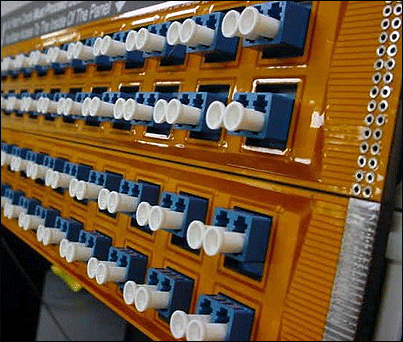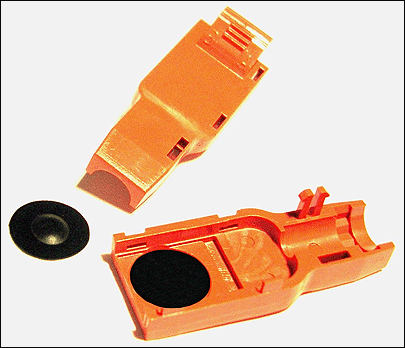Large data centers with as many as 15,000 data cables can potentially go down if just one cable is plugged into the wrong port, says William DiBella, president of Connectivity Technologies (ConTech). The Carrollton, Texas, manufacturer provides fiber optic and copper cabling infrastructure systems for data centers and local area networks (LANs). For large corporations, he adds, a data-center failure can be a catastrophic event.
Network infrastructure management software, such as the Obtain 24/7 program made by Knowledge Flow and resold by ConTech, helps IT staff plan and manage the configuration of hardware and cabling within a data center. This software can also ensure that cables are correctly laid out, based on data entered manually into the program by IT staff. When equipment is moved or rearranged, DiBella notes, upgrading software to reflect the new hardware and cabling configurations is also a manual process, which can be slow and prone to errors.
With Genesys, ConTech’s new RFID-based asset-management system, IT staff can always know which cabling is installed where, and whether any cables have been unplugged. Genesys enables users to track the cable configuration through a combination of RFID technology, LED displays and software. The Genesys system can also track vital IT devices, he says, such as servers and memory tapes, as well as the personnel in whose possession the assets reside at any given time.
Genesys is comprised of both middleware and hardware components, with the hardware split into two categories. The tags and readers used to identify cabling operate at high frequency (HF) and comply with the ISO 15693 standard, while tags and readers for tracking larger assets, such as servers, operate at ultrahigh frequency (UHF) and comply with the EPC Gen 2 (ISO 18000-6C) standard. According to DiBella, HF was chosen for the cable couplings because ConTech found it more suited to reading large numbers of tags in very close proximity, and in a metal-rich environment.
The HF tags are pre-encoded with an ID that the system reads when the cable is inserted into a board of receiving ports known as a patch panel. ConTech has developed an HF interrogator antenna system in the form of a cover that fits onto a patch panel. With this cover, an individual RFID antenna encircles each port on the patch panel, enabling the reader to generate an interrogation field around each cable port. The reader sends the IDs of all the cables it reads to the Genesys middleware, which populates databases in the Obtain 24/7 program with the cable ID and associated data.
The middleware associates each cable’s unique ID number with a body of data about that cable, such as the data speeds it supports, its bandwidth and, in the case of optic fiber, the grade of fiber inside the cable. All of this data is sent to Obtain, DiBella says, and is useful to IT staff members as they configure the IT assets. Before the cabling is installed, the staff completes a work order specifying the path each cable must take, down to the patch panel and port number. (For example, the work order might indicate that one end of cable 1 must be connected to patch panel A, port 12, and the other end must be plugged into patch panel B, port 3.) This information is entered into Obtain before the job is started.
As each cable is inserted, the tag embedded in the coupling is read and its ID is sent to Obtain through the Genesys middleware. Obtain verifies that the path of the cable is correct, as per the work order. If the path is incorrect, Obtain sends an alert back to Genesys, which triggers a red LED indicator built into the customized patch panel covering ConTech developed for Genesys.
As the cables are inserted into the panel, the readers keep a record of all the tags in each patch panel’s read range, which is created by the antenna built into the cover. ConTech has engineered this antenna to keep its read range very short. As such, only cables placed into a port securely can be read—if any cable is pulled out of a port, the reader will lose the tag’s signal. When this happens, Genesys sends an alert through Obtain that a cable is unplugged.
For tracking servers and other assets, ConTech has worked with its UHF tag supplier to create a passive UHF RFID smart label able to operate properly when applied to metal. A foam backing on the label provides a buffer between the RFID inlay embedded in the label and the metallic housing used on the IT asset, preventing the metal from interfering with the interrogator’s RF signal. UHF antennas are mounted above the cabinets where servers and other UHF-tagged IT assets are placed. Readers can be placed around doorways to track the movements of these IT assets into and out of data centers.
Employees wear wristbands with embedded EPC Gen 2 RFID inlays encoded with their employee ID numbers. Thus, any workers moving tagged assets can be tracked along with the assets themselves—both by readers built into the cabinets and those along choke points or doorways. The Genesys middleware also links this data to the Obtain software.
Obtain can aggregate the cabling and asset data, creating diagrams showing the physical layout of the assets within a data center. Currently, rather than requiring manual import of the asset and cable information, the RFID tag data automates this process.
DiBella says ConTech has been developing the Genesys system for the past two years. The UHF readers are provided by Sirit, DiBella says, though he declines to reveal the companies providing the UHF tags or any of the HF hardware, citing non-disclosure agreements ConTech made to maintain a competitive advantage for Genesys. He says ConTech has licensed some of the IP used in the coupling tag and antenna design, but that it developed the rest of the platform in-house. While none of ConTech’s customers are testing or deploying Genesys, he notes that there are a number of interested parties.



